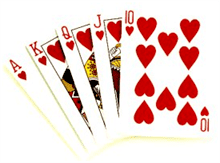“The Numbers Game: Understanding the Mathematics of Poker” is an article that delves into the mathematical aspects of the popular card game, poker. It explores how various mathematical concepts and principles can be applied to improve one’s understanding and decision-making in poker. By analyzing probabilities, odds, and expected values, this article aims to provide players with a solid foundation in the mathematical aspects of poker, ultimately helping them make more informed and strategic decisions at the poker table.
The Importance of Probability in Poker Mathematics
One of the most important mathematical concepts in poker is probability. Probability is the branch of mathematics that deals with the likelihood of events occurring. In poker, understanding the probability of certain outcomes can help players make informed decisions and calculate their expected value.
Expected value, or EV, is a key concept in poker mathematics. It is a way of quantifying the value of a particular decision or action. By calculating the expected value of a play, players can determine whether it is a profitable move in the long run. To calculate the expected value, players need to consider the probability of each possible outcome and the potential payoff or loss associated with each outcome.
For example, let’s say a player is considering whether to call a bet on the river with a flush draw. To calculate the expected value of this decision, the player needs to consider the probability of completing the flush and the potential payoff if they do. If the probability of completing the flush is high and the potential payoff is greater than the cost of the call, then the expected value of the play is positive, and it would be a profitable move in the long run.
Understanding probability also helps players make better decisions when it comes to starting hand selection. Each starting hand in poker has a certain probability of winning against other hands. By knowing the probability of winning with different starting hands, players can make more informed decisions about whether to play a hand or fold.
Another important aspect of probability in poker is pot odds. Pot odds are a way of comparing the current size of the pot to the cost of a contemplated call. By comparing the pot odds to the probability of completing a hand, players can determine whether it is mathematically correct to make a call.
For example, if the pot is $100 and a player needs to call a $20 bet to continue in the hand, the pot odds are 5 to 1. If the player’s probability of completing their hand is greater than 1 in 5, then it would be mathematically correct to make the call. If the probability is lower, then it would be a losing play in the long run.
Understanding the importance of probability in poker mathematics can give players a significant advantage at the table. By calculating the expected value of their decisions, considering the probability of winning with different starting hands, and comparing pot odds to the probability of completing a hand, players can make more informed decisions and improve their chances of winning.
Understanding Expected Value in Poker Mathematics
Expected value, often abbreviated as EV, is a mathematical calculation that represents the average amount of money a player can expect to win or lose on a particular bet or decision over the long run. It is a way of quantifying the potential profitability of a given action. By understanding expected value, players can make more rational decisions based on the likelihood of winning or losing.
To calculate expected value, one must consider both the probability of winning and the potential payoff. For example, let’s say a player is considering whether to call a bet on the river. The pot is $100, and the player’s opponent bets $50. The player believes they have a 25% chance of winning the hand. To calculate the expected value, the player multiplies the probability of winning (0.25) by the potential payoff ($100 + $50 = $150) and subtracts the probability of losing (0.75) multiplied by the amount they would lose ($50). In this case, the expected value would be ($0.25 * $150) – ($0.75 * $50) = $37.50 – $37.50 = $0.
If the expected value is positive, it means that the player can expect to make money in the long run by making that particular decision. If the expected value is negative, it means that the player can expect to lose money over time. By calculating the expected value of different actions, players can make more informed decisions that maximize their potential profitability.
Understanding expected value is particularly important in situations where there is uncertainty. For example, when deciding whether to call a bet or fold, a player must consider the potential payoff if they win the hand and the likelihood of winning. By calculating the expected value, players can determine whether it is mathematically profitable to make the call or fold.
Expected value can also be used to analyze the profitability of different betting strategies. For example, a player may be considering whether to make a large bet or a small bet on the river. By calculating the expected value of each option, the player can determine which strategy is more likely to be profitable in the long run.
It is important to note that expected value is a long-term concept. In the short term, luck can play a significant role in the outcome of individual hands. However, over a large number of hands, the expected value will become more accurate and reflect the true profitability of a particular decision.
Analyzing Pot Odds and Implied Odds in Poker Mathematics
One important concept in poker mathematics is pot odds. Pot odds refer to the ratio of the current size of the pot to the cost of a contemplated call. By comparing the pot odds to the odds of completing a drawing hand, players can determine whether it is mathematically profitable to make a call.
To calculate pot odds, players need to know the size of the pot and the cost of the call. For example, if the pot is $100 and the cost of the call is $20, the pot odds are 5 to 1. This means that for every $1 you invest, you stand to win $5 if you win the hand. If the odds of completing your drawing hand are better than 5 to 1, it would be a mathematically profitable call.
Pot odds can help players make decisions about whether to call, raise, or fold. If the pot odds are favorable, it may be worth making the call even if the player’s hand is not particularly strong. On the other hand, if the pot odds are unfavorable, it may be wise to fold, even if the player has a decent hand.
Another important concept in poker mathematics is implied odds. Implied odds refer to the potential future bets that can be won if a drawing hand is completed. Unlike pot odds, which only consider the current size of the pot, implied odds take into account the potential future bets that can be won if the player’s hand improves.
Calculating implied odds can be more challenging than calculating pot odds because it requires predicting future betting patterns. However, experienced players can make educated guesses based on their knowledge of their opponents’ playing styles and tendencies.
Implied odds can be particularly useful in situations where the pot odds are not favorable, but there is a high likelihood of winning a large pot if the player’s hand improves. In these cases, the potential future bets that can be won may outweigh the immediate pot odds, making it a profitable decision to continue playing.
Understanding pot odds and implied odds is crucial for making informed decisions at the poker table. By considering the mathematical aspects of the game, players can improve their chances of winning and minimize their losses. However, it is important to remember that poker is not purely a game of numbers. It also requires skill, strategy, and the ability to read opponents. The numbers game is just one piece of the puzzle.
Exploring Game Theory and its Application in Poker Mathematics
One of the key concepts in poker mathematics is probability. Probability is the branch of mathematics that deals with the likelihood of an event occurring. In poker, understanding probability can help players make informed decisions about whether to bet, call, or fold.
For example, let’s say a player is dealt two cards of the same suit, known as a suited hand. The probability of being dealt a suited hand is approximately 23.5%. This means that in a typical game, a player can expect to be dealt a suited hand about one out of every four hands. Knowing this probability can help a player determine whether it is worth staying in the hand or folding.
Another important concept in poker mathematics is expected value. Expected value is a way of calculating the average outcome of a situation over the long run. In poker, expected value can help players determine whether a particular bet is likely to be profitable or not.
To calculate expected value, a player needs to consider both the probability of winning a hand and the potential payout. For example, let’s say a player has a 25% chance of winning a hand and the pot is $100. The expected value of betting in this situation would be $25 ($100 x 0.25). If the player’s bet is less than $25, it would be considered a profitable bet in the long run.
Game theory is another mathematical concept that can be applied to poker. Game theory is the study of strategic decision-making in situations where the outcome of one person’s decision depends on the decisions of others. In poker, game theory can help players determine the optimal strategy for a given situation.
For example, in a game of Texas Hold’em, a player needs to decide whether to bet, call, or fold based on their hand and the actions of the other players. Game theory can help players determine the best course of action by considering the potential actions and reactions of their opponents.
Understanding the mathematics of poker can also help players with bankroll management. Bankroll management is the practice of managing one’s poker funds to ensure long-term success. By understanding the mathematics of poker, players can make informed decisions about how much to bet and when to take risks.
Mastering Hand Ranges and Equity Calculations in Poker Mathematics
One important concept in poker mathematics is hand ranges. A hand range is a set of possible hands that a player could have based on their actions and the information available. By understanding hand ranges, players can make better decisions about their own hands and how they should play them.
To determine a player’s hand range, you need to consider their position at the table, their betting patterns, and the community cards on the board. For example, if a player in early position raises before the flop, their hand range is likely to be stronger than if they were in a later position. By narrowing down a player’s hand range, you can make more accurate predictions about the strength of their hand and adjust your own strategy accordingly.
Equity calculations are another important aspect of poker mathematics. Equity is a measure of a player’s expected value in a hand. It represents the percentage of the pot that a player can expect to win on average over the long run. By calculating equity, players can determine whether it is profitable to continue in a hand or fold.
To calculate equity, you need to consider the possible outcomes of a hand and the probability of each outcome occurring. For example, if you have a flush draw with nine outs (cards that will complete your flush), you can calculate your equity by dividing the number of outs by the number of unseen cards. In this case, your equity would be approximately 36%.
Equity calculations can also be used to compare the strength of different hands. For example, if you have a pair of aces and your opponent has a pair of kings, you can calculate the equity of each hand to determine which one is more likely to win. This information can help you make better decisions about whether to bet, raise, or fold.
Mastering hand ranges and equity calculations requires practice and experience. It is important to study and analyze different hand scenarios to develop a better understanding of the mathematics involved. Many professional poker players spend hours studying hand histories and analyzing their own play to improve their skills.
In addition to hand ranges and equity calculations, there are many other mathematical concepts that can be applied to poker. These include pot odds, expected value, and probability theory. By understanding these concepts and how they relate to the game of poker, players can make more informed decisions and increase their chances of winning.
In conclusion, the mathematics of poker is a complex and fascinating subject. By understanding hand ranges and equity calculations, players can make better decisions at the table and increase their chances of winning. It is important to study and practice these concepts to improve your skills and become a more successful poker player. So, the next time you sit down at the poker table, remember that there is more to the game than meets the eye.




